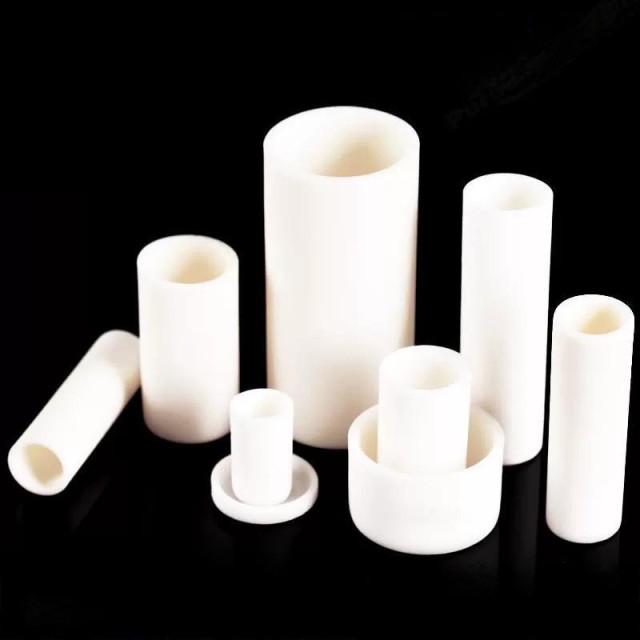
fine ceramics
Engineering Advanced Fine Ceramics Alumina Al2O3 Crucible With Lid Cylindrical Laboratory Crucible
Item Number : KM-C02
Price varies based on specs and customizations
- Material
- Aluminum oxide
- Specification
- See the form
Shipping:
Contact us to get shipping details Enjoy On-time Dispatch Guarantee.
Why Choose Us
Reliable PartnerEasy ordering process, quality products, and dedicated support for your business success.
Application
Alumina ceramic crucibles are versatile and durable vessels for thermal analysis testing. Made of high-quality alumina ceramic, it has the characteristics of high melting point, strong hardness, good chemical stability, and can withstand extreme temperatures, corrosion and wear. Its smooth surface allows for easy sample removal, while its high thermal conductivity ensures accurate temperature readings during testing. It is a good material for high temperature resistance and chemical corrosion resistance. Alumina sample pans are widely used in thermal analysis such as DTA and DSC to provide consistent and precise results in thermal analysis tests.
- Material Testing: Alumina ceramic crucibles for precise thermogravimetric analysis.
- Metallurgical Processes: High-temperature and chemically resistant crucibles for smelting, casting, and refining metal alloys.
- Environmental Testing: Acid-resistant crucibles for accurate measurement of pollutants and toxins in soil and water samples.
- Drug Research: Crucibles used to analyze thermal properties of drug molecules, aiding in drug development.
- Ceramic and Glass Manufacturing: Crucibles designed to withstand extreme temperatures and thermal shock for molten glass and ceramic materials during production.
Detail & Parameter
Model 1
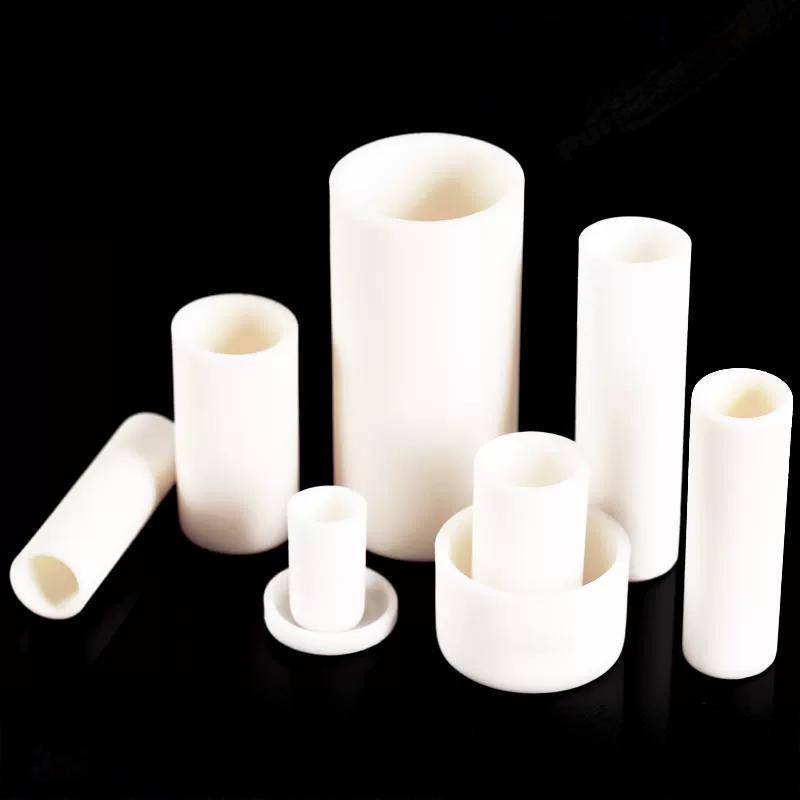
| 0.4ml(ф10x10mm) | 4ml(ф14x45mm) | 23ml(ф30x55mm) | 74ml(ф45x65mm) | 150ml(ф90x30mm) | 260ml(ф75x65mm) | 470ml(φ80x120mm) | 1400ml(ф130x130mm) |
| 0.8ml(ф12x12mm) | 6.5ml(ф19x35mm) | 25ml(ф28x58mm) | 85ml(ф50x60mm) | 160ml(ф65x65mm) | 275ml(ф60x120mm) | 480ml(ф95x95mm) | 1600ml(ф140x140mm) |
| 1.5ml(ф20x10mm) | 7ml(ф30x20mm) | 28ml(ф50x25mm) | 89ml(ф60x40mm) | 198ml(ф85x50mm) | 280ml(ф80x80mm) | 560ml(ф130x60mm) | 2000ml(ф150x140mm) |
| 3ml (φ12x40mm) | 7.5ml(ф28x17mm) | 35ml(ф40x40mm) | 93ml(ф40x100mm) | 220ml(ф60x100mm) | 300ml(ф90x65mm) | 630ml(ф100x100mm) | 2400ml(ф230x80mm) |
| 3ml(ф16x20mm) | 9ml(φ30x25mm) | 38ml(ф35x51mm) | 120ml(φ50x80mm) | 220ml(ф70x70mm) | 310ml(ф70x100mm) | 840ml(ф150x65mm) | 2500ml(ф150x180mm) |
| 3ml(ф20x20mm) | 12ml(ф30x28mm) | 40ml(ф50x30mm) | 130ml(ф60x60mm) | 220ml(ф100x35mm) | 330ml(ф95x60mm) | 1000ml(ф115x130mm) | 2520ml(ф200x100mm) |
| 3.5ml(ф16x28mm) | 13ml(ф30x30mm) | 63ml(ф50x45mm) | 130ml(ф70x50mm) | 250ml(ф85x60mm) | 360ml(ф80x100mm) | 1100ml(ф100x180mm) | 2700ml(ф160x160mm) |
| 3.5ml(ф18x26mm) | 21ml(ф35x30mm) | 70ml(ф50x50mm) | 145ml(ф50x100mm) | 250ml(ф95x50mm) | 450ml(φ90x90mm) | 1350ml(ф125x150mm) | 3400ml(ф180x170mm) |
| 5240ml(ф200x200mm) |
Model 2

| 0.8mlWith convex cover(ф12x12) | 3.5mlWith convex cover(ф16x28) | 11mlWith convex cover(ф19x58) | 28mlWith buckle cover(ф50x25) | 53mlWith convex cover(ф40x70) | 100mlwith disc cover(ф58x60) | 280mlwith disc cover(ф80x80) | 1100mlwith disc cover(ф100x180) |
| 1.5mlWith buckle cover(ф20x10) | 3.5mlWith buckle cover(ф16x28) | 12mlWith convex cover(ф30x28) | 29mlWith convex cover(ф40x35) | 61mlWith convex cover(o40x80) | 120mlWith convex cover(ф50x80) | 280mlWith buckle cover(ф80x80) | 1350mlwith disc cover(ф125x150) |
| 1.5mlWith convex cover(ф20x10) | 3.5mlWith convex cover(ф18x26) | 12mlWith buckle cover(ф30x28) | 35mlWith convex cover(ф40x40) | 63mlWith convex cover(ф50x45) | 130mlwith disc cover(ф60x60) | 300mlWith buckle cover(ф90x65) | 1400mlwith disc cover(ф130x130) |
| 3mlWith convex cover(ф12x40) | 4mlWith convex cover(ф14x45) | 13mlWith convex cover(ф30x30) | 38mlWith convex cover(ф35x50) | 63mlWith buckle cover(ф50x45) | 130mlwith disc cover(ф70x50) | 450mlwith disc cover(ф90x90) | 1600mlwith disc cover(ф140x140) |
| 2mlWith convex cover(ф16x20) | 6.5mlWith convex cover(ф19x35) | 13mlWith buckle cover(ф30x30) | 38mlWith buckle cover(ф35x50) | 70mlWith convex cover(ф50x50) | 150mlwith disc cover(ф90x30) | 450mlWith buckle cover(ф90x90) | 2000mlwith disc cover(ф150x140) |
| 2mlWith buckle cover(ф16x20) | 7mlWith convex cover(ф30x20) | 15mlWith convex cover(ф47x13) | 40mlWith convex cover(ф50x30) | 70mlWith buckle cover(ф50x50) | 150mlWith buckle cover(ф90x30) | 560mlwith disc cover(ф130x60) | 2400mlwith disc cover(ф230x80) |
| 3mlWith buckle cover(ф20x18) | 7.5mlWith convex cover(ф28x17) | 23mlWith convex cover(ф30x55) | 50mlWith buckle cover(ф35x70) | 73mlWith convex cover(ф35x100) | 160mlwith disc cover(ф65x65) | 630mlwith disc cover(ф100x100) | 2500mlwith disc cover(ф150x180) |
| 3mlWith convex cover(ф20x18) | 8mlWith buckle cover(ф25x25) | 23mlWith buckle cover(ф30x55) | 50mlWith convex cover(ф40x60) | 85mlWith convex cover(ф50x60) | 163mlwith disc cover(ф90x35) | 840mlwith disc cover(ф150x65) | 2700mlwith disc cover(ф160x160) |
| 3mlWith convex cover(ф20x20) | 9mlWith convex cover(ф20x50) | 25mlWith convex cover(ф28x58) | 52mlWith buckle cover(ф30x100) | 85mlWith buckle cover(ф50x60) | 220mlwith disc cover(ф60x100) | 950mlwith disc cover(ф120x120) | 3400mlwith disc cover(ф180x170) |
| 3mlWith buckle cover(ф20x20) | 9mlWith convex cover(ф30x25) | 28mlWith convex cover(ф50x25) | 52mlWith convex cover(ф30x100) | 95mlwith disc cover(ф95x20) | 260mlwith disc cover(ф70x70) | 1000mlwith disc cover(ф115x130) |
Model 3

| 0.4ml(10x10) | 1.5ml(13x24) | 3ml(20x18) | 5ml(15x70) | 8ml(25x25) | 15ml(30x28) | 39ml(35x58) |
| 0.7ml(20x4) | 2ml(30x5) | 3ml(35x6) | 6ml(16x50) | 9ml(20x50) | 15ml(47x13) | 50ml(35x70) |
| 1ml(10x50) | 2.5ml(10x60) | 4ml(12x150) | 6.5ml(19x35) | 11ml(19x58) | 18ml(23x60) | 50ml(40x60) |
| 1.2ml(11x20) | 3ml(12x40) | 4ml(14x45) | 8ml(16x56) | 12ml(55x8) | 29ml(40x35) |
Model 4

| One large (ф58x60) and seven small (ф16x50) | One large (100x40x20) and three small (ф28x17) | One large (120x60x20) two small (100x20x20 semicircle) |
| One large (ф70x70) and three small (ф28x58) | One large (100x40x20) and three small (ф30x30) | One large (120x60x40) three small (40x35x25 semicircle) |
| One large (100x30x20) and four small (ф20x20) | One large (100x100x40) nine small (10ml) | One large (120x80x30) six small (20ml) |
| One big (100x30x20) five small (ф18x26) | One large (115x65x45) four small (50x25x35) | One large (120x80x40) six small (15ml) |
Model 5
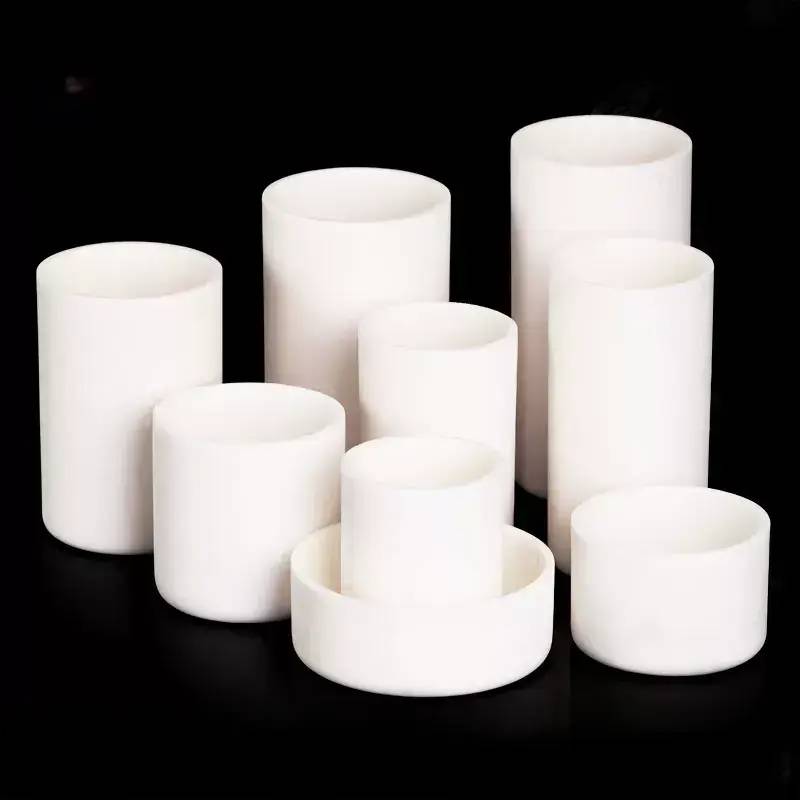
| 52ml(30x100) | 80ml(56x50) | 119ml(40x135) | 180ml(50x120) | 270ml(90x60) |
| 53ml(40x70) | 95ml(95x20) | 127ml(45x110) | 185ml(59x87) | 300ml(100x50) |
| 61ml(40x80) | 100ml(58x60) | 140ml(115x20) | 230ml(100x40) | 375ml(70x120) |
| 73ml(35x100) | 105ml(75x27) | 163ml(90x35) | 250ml(70x90) | 420ml(70x145) |
Model 6

| 2mlwith outer buckle cap(Ф16x20) | 6mlwith inner convex cap(Ф16x50) | 220ml with disc cover (Ф100x35) | 300ml with disc cover (Ф100x50) | 610ml with disc cover (Ф80x155) | 900ml with disc cover (Ф115x110) |
| 2mlwith inner convex cap(Ф16x20) | 8mlwith buckle cap(Ф16x56) | 250ml with disc cover (o85x60) | 330ml with disc cover (Ф95x60) | 610mlwith buckle cap(Ф80x155) | 1050ml with disc cover (Ф150x80) |
| 3.5mlwith buckle cap(Ф16x28) | 8mlwith inner convex cap(Ф16x56) | 250mlwith buckle cap(Ф85x60) | 360ml with disc cover (Ф80x100) | 790ml with disc cover (Ф80x200) | 1100ml with disc cover (Ф100x180) |
| 3.5mlwith inner convex cap(Ф16x28) | 50ml with disc cover (Ф40x60) | 260ml with disc cover (Ф75x65) | 360mlwith buckle cap(Ф80x100) | 790mlwith buckle cap(Ф80x200) | |
| 5mlwith inner convex cap(Ф15x70) | 130ml with disc cover (Ф70x50) | 270ml with disc cover (Ф90x60) | 420ml with disc cover (Ф70x145) | 860ml with disc cover (Ф140x70) | |
| 6mlwith buckle cap(Ф16x50) | 163ml with disc cover (Ф90x35) | 270mlwith buckle cap(Ф90x60) | 560ml with disc cover (Ф115x70) | 900mlwith disc cover(Ф110x120) |
Model 7

| 0.7ml with disc cap (Ф20x4) | 4ml with inner convex cap (Ф14x45) | 8ml with buckle cap (Ф25x25) | 1240ml with disc cover (Ф125x125) | 2500ml with disc cover (Ф150x180) |
| 2ml with disc cap (Ф30x5) | 6.5ml with inner convex cap (Ф19x35) | 11ml with inner convex cap (Ф19x58) | 2700ml with disc cover (Ф160x160) | 2600ml with disc cover (Ф130x245) |
| 3ml with disc cap (Ф35x6) | 7.5ml with inner convex cap (Ф28x17) | 15ml with buckle cap (Ф30x30) | 1290ml with disc cover (Ф115x155) | 3800ml with disc cover (Ф160x240) |
| 3ml with outer buckle cap (Ф35x6) | 8ml with inner convex cap (Ф25x25) | 25ml with inner convex cap (Ф28x58) | 1460ml with disc cover (Ф140x120) |
Model 8

| 3ml with disc cap (Ф20x18) | 74ml with disc cover (Ф45x65) | 450ml with buckle cover (Ф90x90) | 630ml with disc cover (Ф100x100) | 1000ml with disc cover (Ф115x130) | 2400ml with inner convex cap (Ф230x80) |
| 21ml with inner convex cap (Ф35x30) | 95ml with disc cover (Ф95x20) | 470ml with disc cover (Ф80x120) | 840ml with disc cover (Ф50x65) | 1350ml with disc cover (Ф125x150) | 2600ml with disc cover (Ф145x195) |
| 21ml with buckle cap (Ф35x30) | 100ml with disc cover (Ф60x55) | 470ml with buckle cover (q80x120) | 900ml with disc cover (Ф80x235) | 1400ml with disc cover (Ф130x130) | 3400ml with disc cover (Ф180x170) |
| 39ml with inner convex cap (Ф35x58) | 127ml with disc cover (Ф45x110) | 480ml with disc cover (Ф95x95) | 900ml with buckle cover (Ф80x235) | 1600ml with disc cover (Ф140x140) | |
| 39ml with buckle cap (Ф35x58) | 450ml with disc cover (Ф90x90) | 560ml with disc cover (Ф130x60) | 950ml with disc cover (Ф120x120) | 2000ml with disc cover (Ф150x140) |
Model 9

| 73ml with buckle cap (Ф35x100) | 100ml with disc cover (Ф58x60) | 130ml with disc cover (Ф65x50) | 160ml with disc cover (Ф65x65) | 220ml with disc cover (Ф60x100) | 275ml with disc cover (Ф60x120) |
| 74ml with buckle cap (Ф45x65) | 119ml with inner convex cap (Ф40x135) | 140ml with disc cover (Ф115x20) | 180ml with inner convex cap (Ф50x120) | 230ml with disc cover (Ф100x40) | 280ml with buckle cover (Ф80x80) |
| 80ml with disc cover (Ф56x50) | 120ml with buckle cap (Ф50x80) | 145ml with inner convex cap (Ф50x100) | 180ml with buckle cover (Ф50x120) | 250ml with disc cover (ф70x90) | 300ml with buckle cover (Ф90x65) |
| 85ml with buckle cap (Ф50x60) | 127ml with buckle cover (Ф45x110) | 145ml with buckle cap (Ф50x100) | 185ml with disc cover (Ф59x87) | 250ml with disc cover (Ф95x50) | 310ml with disc cover (Ф70x100) |
| 93ml with disc cap (Ф40x100) | 130ml with disc cover (Ф60x60) | 150ml with buckle cover (Ф90x30) | 198ml with buckle cover (Ф85x50) | 260ml with disc cover (Ф70x70) | 375ml with disc cover (Ф70x120) |
Model 10
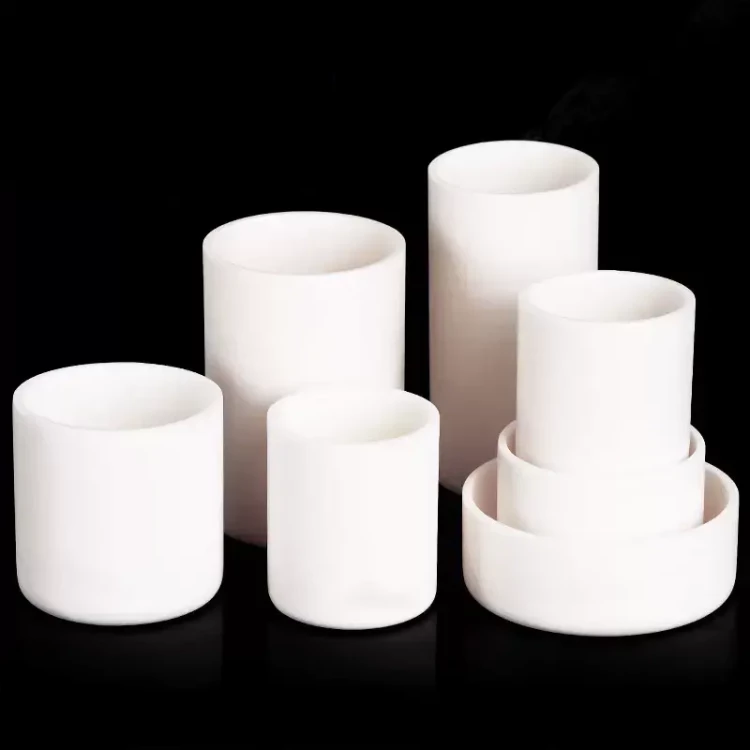
| 560ml(115x70) | 900ml(110x120) | 1100ml(107x160) | 2600ml(130x245) |
| 610ml(80x155) | 900ml(115x110) | 1240ml(125x125) | 2600ml(145x195) |
| 790ml(80x200) | 950ml(120x120) | 1290ml(115x155) | 3800ml(160x240) |
| 860ml(140x70) | 1000ml(104x155) | 1460ml(140x120) | 5200ml(185x240) |
| 900ml(80x235) | 1050ml(150x80) | 2000ml(150x140) |
Model 11

| 2520ml(Ф200x100) | 5200ml(Ф185x240) | 5240ml(Ф200x200) |
Model 12
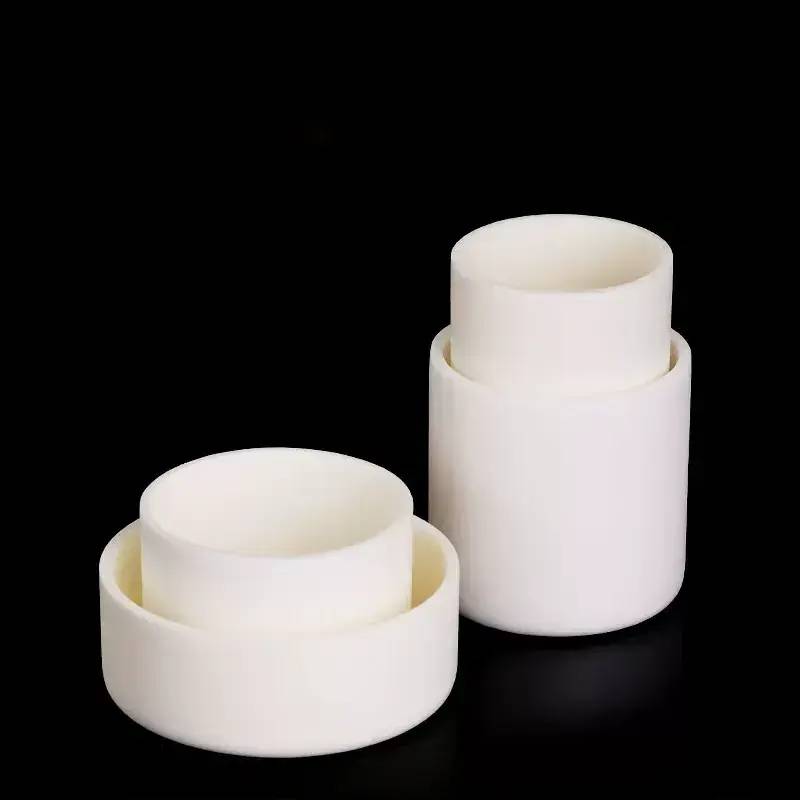
| 50ml (Ф40x60) | 330ml (Ф95x60) | 790ml (Ф80x200) | 1240ml (Ф125x125) | 3800ml (Ф160x240) |
| 163ml (Ф90x35) | 360ml (Ф80x100) | 860ml (Ф140x70) | 1290ml (o115x155) | 5200ml (Ф185x240) |
| 220ml (Ф100x35) | 420ml (Ф70x145) | 900ml (Ф110x120) | 1460ml (Ф140x120) | 5240ml (Ф200x200) |
| 250ml (Ф85x60) | 470ml (Ф80x120) | 900ml (Ф115x110) | 2500ml(Ф150x180) | |
| 270ml (Ф90x60) | 560ml (Ф115x70) | 1050ml (Ф150x80) | 2520ml (Ф200x100) | |
| 300ml (Ф100x50) | 610ml (Ф80x155) | 1100ml (Ф100x180) | 2600ml(Ф130x245) |
Model 13

| Customized Ф56x50mm without cover | Customized Ф56x50mm with cover |

The crucibles we show are available in different sizes and custom sizes are available on request.
Advantages
- High temperature resistance: long-term use at 1600°C, short-term use at 1800°C (Al2O3≥99%), suitable for melting, sintering, annealing and other occasions.
- Low Thermal Conductivity: Minimizes thermal shock for safe handling even when very hot.
- Superior Durability: Withstands multiple heating and cooling cycles without cracking or deforming.
- Easy to clean and cost-effective.
- Broad Material Compatibility: Compatible with metals, salts, organics and a wide variety of laboratory chemicals.
- Non-toxic, safe for laboratory use.
FAQ
What Are Advanced Ceramics?
What Are The Main Applications Of Fine Ceramics?
What Are Engineering Ceramics?
What Are The Main Differences Between Square And Cylindrical Crucibles?
What Are The Common Applications Of Alumina Crucibles?
What Are The Main Types Of Advanced Ceramics?
What Are The Main Types Of Fine Ceramics?
What Are The Main Types Of Engineering Ceramics?
What Are The Advantages Of Using Alumina Crucibles?
What Are The Applications Of Advanced Ceramics?
What Is The Principle Behind Fine Ceramics?
What Are The Applications Of Engineering Ceramics?
How Should Alumina Crucibles Be Handled And Maintained?
How Are Advanced Ceramics Manufactured?
What Are The Advantages Of Using Fine Ceramics?
How Do Engineering Ceramics Differ From Traditional Ceramics?
What Are The Advantages Of Using Advanced Ceramics?
What Are The Advantages Of Using Alumina Ceramics?
What Is The Difference Between Alumina And Zirconia Ceramics?
Why Are Zirconia Ceramics Preferred In Certain Applications?
Why Are Silicon Carbide Ceramics Used In High-temperature Applications?
What Makes Silicon Carbide Ceramics Suitable For High-temperature Applications?
What Makes Boron Nitride Ceramics Unique?
How Are Boron Nitride Ceramics Used In Electronics?
How Do Advanced Ceramics Contribute To Energy Efficiency?
What Is The Manufacturing Process Of Engineering Ceramics?
Can Engineering Ceramics Be Customized For Specific Applications?
4.8
out of
5
The alumina boat crucible is an amazing ceramic material for high-temperature applications that require contamination-free outcomes. It can withstand extreme temperatures up to 1800°C, making it perfect for even the most demanding experiments.
4.7
out of
5
I am very impressed with the quality of these crucibles. They are made of high-quality alumina, which makes them very durable and perfect for all lab metal and nonmetal samples for analysis and glass melting.
4.9
out of
5
These crucibles are a must-have for any laboratory. They are easy to clean and can be used for a variety of experiments. I highly recommend them.
4.6
out of
5
I am very happy with these crucibles. They are exactly what I needed for my research. They are made of high-quality materials and are very durable.
4.8
out of
5
These crucibles are a great value for the money. They are made of high-quality materials and are very durable. I have used them for a variety of experiments and they have performed flawlessly.
4.7
out of
5
I am very impressed with the quality of these crucibles. They are made of high-quality alumina, which makes them very durable and perfect for all lab metal and nonmetal samples for analysis and glass melting.
4.9
out of
5
These crucibles are a must-have for any laboratory. They are easy to clean and can be used for a variety of experiments. I highly recommend them.
4.6
out of
5
I am very happy with these crucibles. They are exactly what I needed for my research. They are made of high-quality materials and are very durable.
4.8
out of
5
These crucibles are a great value for the money. They are made of high-quality materials and are very durable. I have used them for a variety of experiments and they have performed flawlessly.
4.7
out of
5
I am very impressed with the quality of these crucibles. They are made of high-quality alumina, which makes them very durable and perfect for all lab metal and nonmetal samples for analysis and glass melting.
4.9
out of
5
These crucibles are a must-have for any laboratory. They are easy to clean and can be used for a variety of experiments. I highly recommend them.
4.6
out of
5
I am very happy with these crucibles. They are exactly what I needed for my research. They are made of high-quality materials and are very durable.
REQUEST A QUOTE
Our professional team will reply to you within one business day. Please feel free to contact us!
Related Products

High Temperature Wear-Resistant Alumina Al2O3 Plate for Engineering Advanced Fine Ceramics
High temperature wear-resistant insulating alumina plate has excellent insulation performance and high temperature resistance.

Engineering Advanced Fine Alumina Al2O3 Ceramic Crucible for Laboratory Muffle Furnace
Alumina ceramic crucibles are used in some materials and metal melting tools, and flat-bottomed crucibles are suitable for melting and processing larger batches of materials with better stability and uniformity.

High Temperature Alumina (Al2O3) Furnace Tube for Engineering Advanced Fine Ceramics
High temperature alumina furnace tube combines the advantages of high hardness of alumina, good chemical inertness and steel, and has excellent wear resistance, thermal shock resistance and mechanical shock resistance.

Engineering Advanced Fine Ceramics Alumina Crucibles (Al2O3) for Thermal Analysis TGA DTA
TGA/DTA thermal analysis vessels are made of aluminum oxide (corundum or aluminum oxide). It can withstand high temperature and is suitable for analyzing materials that require high temperature testing.

Alumina ceramic screws are fastening components made of 99.5% alumina, ideal for extreme applications requiring excellent thermal resistance, electrical insulation and chemical resistance.

Precision Machined Zirconia Ceramic Ball for Engineering Advanced Fine Ceramics
zirconia ceramic ball have the characteristics of high strength, high hardness, PPM wear level, high fracture toughness, good wear resistance, and high specific gravity.

Engineering Advanced Fine Alumina Al2O3 Ceramic Rod Insulated for Industrial Applications
Insulated alumina rod is a fine ceramic material. Alumina rods have excellent electrical insulating properties, high chemical resistance and low thermal expansion.

In the journey of scientific exploration and industrial production, every detail is crucial. Our arc-shaped alumina ceramic crucibles, with their excellent high temperature resistance and stable chemical properties, have become a powerful assistant in laboratories and industrial fields. They are made of high-purity alumina materials and manufactured through precision processes to ensure excellent performance in extreme environments.

High Temperature Aluminum Oxide (Al2O3) Protective Tube for Engineering Advanced Fine Ceramics
Alumina oxide protective tube, also known as high temperature resistant corundum tube or thermocouple protection tube, is a ceramic tube mainly made of alumina (aluminum oxide).

Ceramic Evaporation Boat Set Alumina Crucible for Laboratory Use
It can be used for vapor deposition of various metals and alloys. Most metals can be evaporated completely without loss. Evaporation baskets are reusable.1

High Purity Alumina Granulated Powder for Engineering Advanced Fine Ceramics
Ordinary alumina granulated powder is alumina particles prepared by traditional processes, with a wide range of applications and good market adaptability. This material is known for its high purity, excellent thermal stability and chemical stability, and is suitable for a variety of high-temperature and conventional applications.

Alumina ceramics have good electrical conductivity, mechanical strength and high temperature resistance, while zirconia ceramics are known for their high strength and high toughness and are widely used.

Alumina wear-resistant ceramic washer are used for heat dissipation, which can replace aluminum heat sinks, with high temperature resistance and high thermal conductivity.
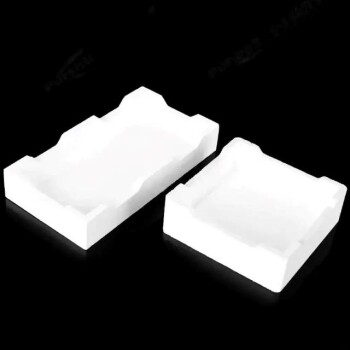
Advanced Engineering Fine Ceramics Alumina Ceramic Saggar for Fine Corundum
Alumina sagger products have the characteristics of high temperature resistance, good thermal shock stability, small expansion coefficient, anti-stripping, and good anti-powdering performance.

Zirconia Ceramic Gasket Insulating Engineering Advanced Fine Ceramics
Zirconia insulating ceramic gasket has high melting point, high resistivity, low thermal expansion coefficient and other properties, making it an important high temperature resistant material, ceramic insulating material and ceramic sunscreen material.

Custom Machined and Molded PTFE Teflon Parts Manufacturer with PTFE Crucible and Lid
PTFE crucibles, made from pure Teflon, offer chemical inertness and resistance from -196°C to 280°C, ensuring compatibility with a wide range of temperatures and chemicals. These crucibles feature machine-finished surfaces for easy cleaning and prevention of contamination, making them ideal for precise laboratory applications.

Engineering Advanced Fine Ceramics Aluminum Oxide Al2O3 Heat Sink for Insulation
The hole structure of the ceramic heat sink increases the heat dissipation area in contact with the air, which greatly enhances the heat dissipation effect, and the heat dissipation effect is better than that of super copper and aluminum.

Precision Machined Yttrium Stabilized Zirconia Ceramic Rod for Engineering Advanced Fine Ceramics
Zirconia ceramic rods are prepared by isostatic pressing, and a uniform, dense and smooth ceramic layer and transition layer are formed at high temperature and high speed.

Engineering Advanced Fine Ceramics Head Tweezers with Pointed Elbow Zirconia Ceramic Tip
Zirconia ceramic tweezers are a high-precision tool made of advanced ceramic materials, especially suitable for operating environments that require high precision and corrosion resistance. This type of tweezers not only has excellent physical properties, but is also popular in the medical and laboratory fields because of its biocompatibility.
Related Articles

Introduction to Various Ceramic Crucibles
An overview of different types of ceramic crucibles, their properties, and applications.

Ceramic Alumina Crucible for Thermal Analysis Test Containers
An in-depth guide on selecting and using ceramic alumina crucibles for thermal analysis tests, focusing on factors affecting test results.

Comprehensive Guide to Atmosphere Furnaces: Types, Applications, and Benefits
Explore the world of atmosphere furnaces with our detailed guide. Learn about their types, applications in metallurgy and beyond, and the benefits they offer for precise material heat treatment.

Alumina Crucibles in Precision Casting
Explores the use of alumina crucibles in precision casting, focusing on their properties and advantages in high-temperature alloy melting.

How to Choose Crucible Materials That Prevent Chemical Degradation in Vacuum Induction Melting
Learn how to choose crucible materials for vacuum induction melting to prevent chemical degradation and optimize alloy purity. Essential guide for industrial applications.

Comparison of Pyrolytic Graphite and Pyrolytic Boron Nitride Crucibles
A detailed comparison of pyrolytic graphite and pyrolytic boron nitride crucibles, focusing on their preparation processes, characteristics, and applications.

The Role and Types of Crucibles in Scientific Experiments
Explores the significance and various types of crucibles in scientific experiments, focusing on their materials and applications.

Comprehensive Guide to Alumina Crucibles in Powder Metallurgy
An in-depth look at the properties, applications, and usage of alumina crucibles in powder metallurgy processes.

Guidelines for the Use of Boron Nitride Crucibles
Instructions on the proper use, precautions, and compatibility of boron nitride crucibles.

Inorganic Non-Metallic Materials: Crucibles
An overview of crucibles made from various inorganic non-metallic materials, their uses, technical parameters, and advantages.

High Purity Graphite Crucible: Features, Production, and Usage
An in-depth look at high purity graphite crucibles, their production processes, and their industrial applications.

Preparation and Performance of Alumina Crucibles for Vacuum Induction Melting Furnace
This article discusses the preparation process and performance benefits of alumina crucibles for vacuum induction melting furnaces, emphasizing thermal stability and long service life.